

|
Back to |
| The Front Page |
| News & Features |

|
21st Century Croquet in India: younger, broader, sportier |
||||||||
|
by Bob Alman with much thanks to Dave Underhill, Klim Seabright, and Manoranjan Pattnaik photos courtesy of Dave Underhill and the Indian Croquet Federation layout by Reuben Edwards Posted March 14, 2013
|
||||||||
|
||||||||
Combine the land areas of the France, Germany, Spain, and the United Kingdom and double it, and you approximate the actual size of the country. You can travel 2,000 miles from south to north or from east to west and still be in India--and that's with the boundaries settled after the partition of the country following independence in 1950. Eleven of India's 28 states sent novice players to the first WCF training camp and National Championships in January. With 130 young novices, along with their coaches and instructors, and housing and food to be arranged, organizing this event was a challenge well met by Croquet Federation of India executive president Manoranjan Pattnaik. Usually, the WCF grants Observer status to a new country with a group of dozens, on any lawn available. The unprecedented scale of India's re-establishment of the sport in the 21st century on the grounds of a large stadium parallels the country's emergence as a major super-power.
The first John Jaques made sporting history--and won a Gold Medal--for introducing croquet into England at London's Great Exhibition in 1851, according to materials produced by the Jaques company, which also declares, "His display there attracted such wide attention that the game speedily became the vogue, not only here but in Europe and throughout the British Empire. It was especially popular in India, reportedly played by the Viceroy himself with a solid ivory mallet, probably made by Jaques as part of their finest set."
India may be the most vivid example of how the sport later devolved in the last century. With first-rate courts and equipment on their palace grounds, the maharajas had no need for a national organization or national fixtures for competition in India in the 19th century.

|
| Dave Underhill is offered help in setting out the spear-style hoops on the hockey practice field by the stadium. The many sponsorship signs in the background are due to the industry of the Indian Croquet Federation's president in generating financial aid. |
When all those grand estates were gradually turned over to the state or became heritage hotels, the lawns remained, but without any structure of support, the sport died, while the game survived to the beginning of the 21st century as a lightweight, casual toy game known as garden croquet in the British Commonwealth or backyard croquet in America.

|
| "We were most impressed by the dazzling dancing of the beautiful young girls at the The Opening Ceremonies," Dave commented. This was only the first use of this stage, which was to become the platform for presenting trophies and acknowledgments five days later after the National Championships. |
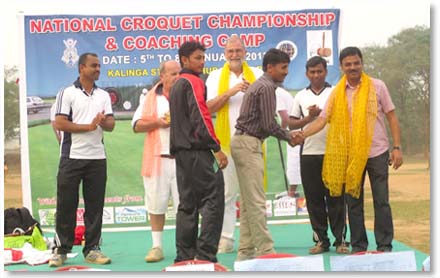
|
| The chief organizer gets special thanks--a handshake and a colorful keepsake from the great inaugural event. |
So croquet needed to be re-invented in India in the 21st century, with an entirely different group of players: not the colonial administrators of that vast land, split into hundreds of princely estates, and not the maharajas, but college students looking for competition with other schools, just as they already do with the "team" version of the mallet sport known as Gateball.
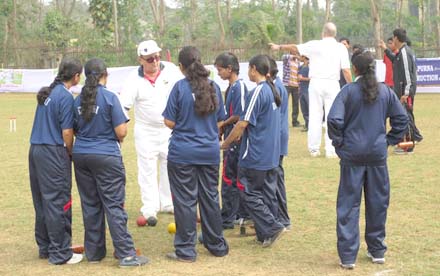
|
| Coaching begins. Klim starts with a group of the girls, while Dave (pointing in the background) takes the boys. |
Oddly, but understandably, the British imports of cricket and polo survived the colonial era and continue to flourish. Now, finally, with India's acceptance as a WCF Observer member, Indian players may soon be competing internationally, along with their brethren in the sports of cricket and polo and Gateball. In fact, three players in the five-day "total immersion" in Golf Croquet in January are flying from India to England in April with Manoranjan for a week-long WCF Croquet Academy at Southwick, with the WCF financing part of their passage along with their course fees.
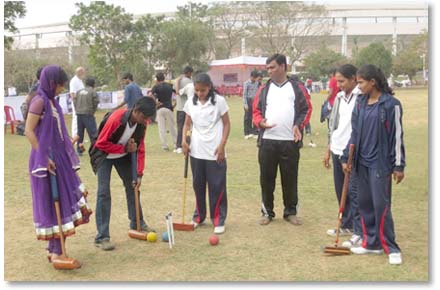
|
| This is what the action looked like, every day. The shelter in the background is for meals, meetings, and other play-breaks. |
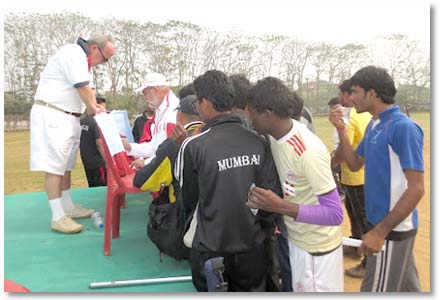
|
| Keeping the scores updated was only one of the jobs Klim and Dave handled as the students crowded around to see how their team compared with those from other schools. |
The backing for this new birth of croquet comes from Indian state funding and donations for the "missionary work" of the Underhills from Switzerland and Brit Klim Seabright, given by British croquet clubs and members of the English Croquet Association. The WCF paid the passage of the Underhills and Klim Seabright to India and shipped out the donated croquet equipment to Bhubaneswar. More equipment is being procured by the new Indian Croquet Federation.
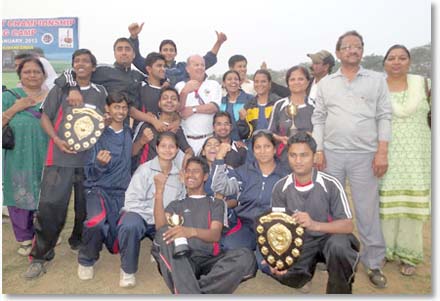
|
| The sizeable Delhi contingent traveled more than a thousand miles to win these proudly-displayed trophies. A bountiful supply of radiant prizes was presented to worthy winners, runner ups and a few extras, each winner accompanied by enthusiastic greetings as they walked to the stage. |
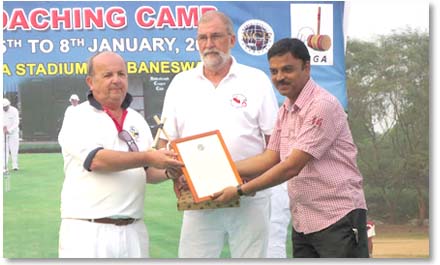
|
| Mounted and immortalized, the letter of support from Secretary-General Martin French will doubtless become a permanent display in India's Croquet Hall of Fame, along with this picture of Klim, Dave, and Manoranjan. |
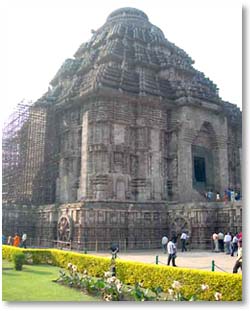
|
| Bhubaneswar is known as "the city of temples," with ruins as old as 3,000 years, but most of the surviving temples dated from the seventh to thirteenth centuries. |
But that's not the reason this city was chosen for the first national croquet school. Logistics dictated that this city was the most accessible overall, to the representatives from 11 of the countries 28 states, and had a stadium with grass suitable for such a week-long gathering as well as the regional airport with connections to most of India.
Bringing it all together was a huge job for Manoranjan Pattnaik, who has also worked to develop Gateball in India, primarily through school groups. According to Dave, "Many of the students took to the game relatively easily, being Gateball players where the skills of judging distance and hitting targets are also required skills."
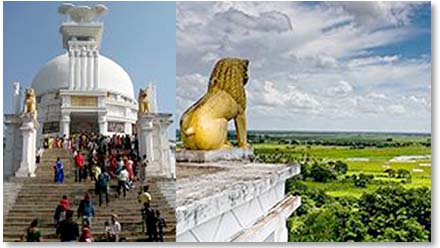
|
| Shanti Stupa, overlooking the plains near the city. |
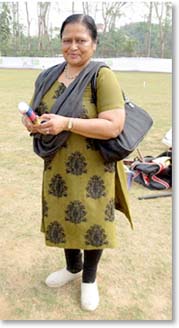
|
| When the pegs arrived with the wrong color order, this teacher was glad to correct them with tape. |
Because of the number of players and the shortage of equipment, it was decided early that all the competition needed to be in doubles. Dave and Klim were disappointed that their Indian hosts preferred a gender-separated event, with different competitions for men and women. "Some of the girls were very good shots," Dave commented.
A bigger long term issue for Indian croquet is croquet courts. The short but sparse grass at Bhubaneswar's Kalinga Stadium was fine for a start, but more suited for Gateball than for croquet. At first, Dave and Klim were surprised that the leaders were so keen on understanding the size of the lawn and the general layout. But they realized those questions were being asked in order to understand whether they could put together such a lawn in their home district.
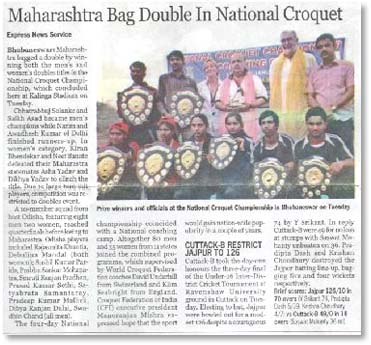
|
| At Bhuebaneswar airport Dave and Klim were surprised to be greeted with flowers and a camera crew. "A mike was pushed into my face, and I came out with something like, 'It's a pleasure to be here in Bubanish.... Busbah.... It's a pleasure to be HERE!'" The press coverage, in all media, was abundant. |
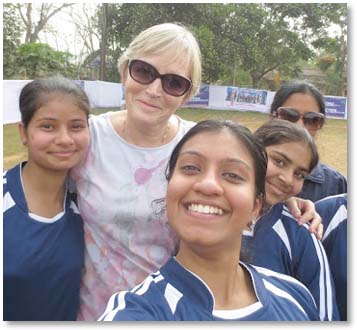
|
| David Underhill's popular wife Vicky played a big role in the success of Indian venture. |
The croquet gods were looking after the tournament directors, as it turned out. Dave and Klim were worried about placements for the final knockout. Fortunately, there was a tie in one of the men's groups, enabling a "neat" knockout start of eight the doubles teams, while two groups of women faced off.
Klim and Dave were impressed with the spirit of the students. "The enthusiasm each and everyone showed in their play and their support of each other was remarkable," Dave said. Such crowd participation would never have been accepted in any other Croquet event in the world--except, perhaps, in Egypt.
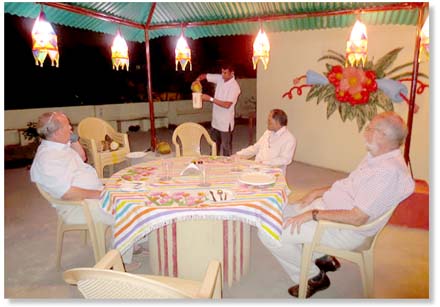
|
| Dinner for Klim, Manoranjan, Dave and Vicky on the roof of their guest house--"different from your typical hotel, but warm, clean, friendly, and with a super chef with a variety of foods and five-star service," according to Dave. Vicky snapped the photo. |

|
| The impression that India is still under construction is compelling, with the old town abutting ultra-modern street scenes like this. |
After all the work of the training camp and tournament, there was time in the following week for a trip around the Golden Triangle of Delhi, Jaipur, Agra and of course the Taj Mahal. Dave and Vicky especially enjoyed the typical tourist experience of "being chauffeur driven along roads where the cars competed for road space with a multitude of lorries of all types, cars with people hanging on the sides, dogs, oxen, cows, camels, donkeys and elephants."
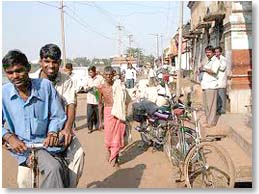
|
| According to Dave, "The week following croquet was equally enchanting, with a trip around the Golden Triangle of Delhi, Jaipur, Agra, and of course the Taj Mahal. The chauffer-drive car competed for road space with a multitude of lorries of all types, cars with people hanging on the sides, dogs, oxen, cows, camels, donkeys and elephants." |
A super-power should compete internationally in cricket, polo, and soccer. The reinvention of croquet as a sport in India will surely confirm and complete the country's leadership credentials.